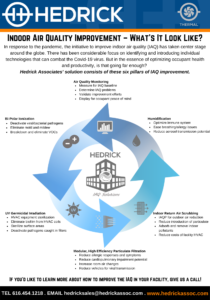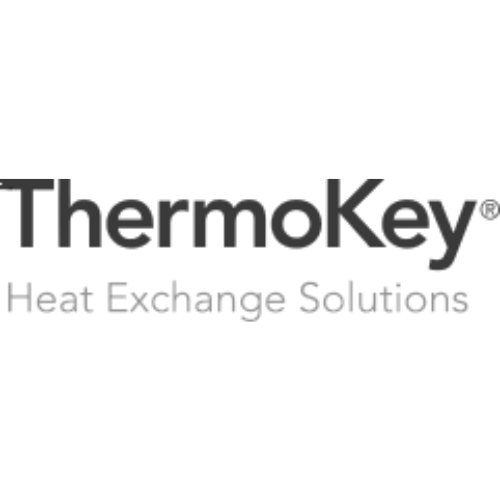Hedrick Announces Their IAQ Strategy!
The future of maintaining healthy indoor environments will be a combination of re-learning social interaction behaviors, adaptation of manual cleaning practices and frequencies, and the integration of HVAC/IAQ improvement technologies that have been validated to offer significant health benefits. Since we are not a firm that offers cleaning and sterilization services, our discussion will pertain to the HVAC/IAQ technologies that can positively impact indoor environments to create a the healthiest spaces possible, reduce absenteeism, increase productivity, and thwart future outbreaks of infectious diseases.
Each of the established IAQ improvement technologies described below has a defined set of strengths and limitations. It is important to understand both of these in order to design and deploy an effective solution. Below is what we would recommend as a set of technologies that can offer significant IAQ improvement potential. These technologies have been validated by laboratory tests, studies, ASHRAE recommendations, and/or healthcare related studies, and we are happy to share this data with any interested parties:
- Monitoring and Validation: The journey towards improved IAQ starts with accurately determining where your baseline is. Not everyone is going to experience the same IAQ challenges. Your indoor air quality will be a function of what is going on inside your building, and also what is going on outside of it. Every building must introduce ventilation (outdoor air) to dilute the concentration of contaminants that are typically found in buildings we occupy. If that outdoor air quality is bad, you already have a challenge to creating healthy indoor air. All buildings are built differently. Companies manufacture different products or perform different services that produce airborne byproducts. Downtown facility locations experience worse outdoor air quality than facilities located on the outside of town. Neighboring companies, airports, freeways, and construction will influence the air you are bringing in to your facility. And on top of that, IAQ changes with the seasons. There is no standard indoor air quality that we are all starting from. Quantifiable improvement in your IAQ requires that you measure and trend your own unique IAQ, so you are certain you are addressing the real problems. (A). We are also seeing a push for IAQ validation – something that can visibly illustrate the results of IAQ technology deployment. Monitoring can also identify unique or emerging problems within our HVAC operation, and allow us to address them. Further – it can be a great visual optic to show building occupants that efforts are being made to address their health and safety concerns. Providing a visual verification that efforts are being made can go a long way to reduce fears and build trust with occupants as they make their way back to the facility setting.
- Ultraviolet Germicidal Irradiation: UVGI is an effective and beneficial technology for surface sterilization. The limitation of UV is that pathogens and other contaminants that we want mitigated MUST pass in the vicinity of the UV light and receive a certain amount of UV energy. This means it is best applied on static surfaces, rather than things that are mobile and moving in and out of line-of-sight. For HVAC, applying UV on air-handler coils offers proven results in mold, mildew, biofilm and pathogen mitigation on the line-of-sight surface. It is even shown to improve air flow and static pressure reductions by reducing bio-film. We support the application of UV on HVAC coils as one piece of the IAQ improvement strategy, and also believe it serves as a valuable HVAC preventative maintenance tool as well.
- Bi-Polar Ionization: Ionization is effective where UV cannot be. Direct exposure to UV is harmful to people, so addressing the actual occupied breathing space with UV is impractical. However, that is where the pathogens originate, whether introduced by occupants or materials that have been contaminated from external sources. It is highly more likely that a cross infection will happen in this space, prior to the potential of the pathogen entering the HVAC system and being inactivated by the coil UV lights. To have an effective approach to reducing space infection potential, we need a technology that is constantly and actively working in the breathing space to inactivate pathogens that is not harmful to people. Ionization fits this need exceptionally well. Furthermore, ionization has proven to improve the efficiency of filtration. Ionization technology causes very small particulate (that would normally pass through air filters) to combine with other airborne particulate to create larger particles. This allows for more efficient filtration and a better IAQ result. Laboratory test and studies validate the effectiveness of this technology for these purposes. Ionization units are mounted inside supply air ducts, inside air-handlers downstream of the coils, or mounted directly on split systems and cassettes.
- Humidification: There are a wealth of studies available that show the positive effect that humidification has on our immune system performance, as well as the effectiveness of it reducing the “hang-time” of airborne pathogens. The importance of humidification as an IAQ and infection reduction technology cannot be understated. Maintaining an indoor RH between 40% and 60% delivers exceptional infection transmission reduction and may be one of the most effective measures that can be taken to impact airborne transmission. However, it can come at a high cost depending on the ventilation practices of the facility.
- VOC/C02 Scrubbing and Reduction of Outdoor Air: Rumors abound that the best way to address pathogen mitigation is 100% outdoor ventilation air. At first glance, it would seem to be a logical approach to addressing the virus concerns we are facing. However, not only can the results of 100% outdoor air NOT meet expectations, it can create other significant IAQ problems and drastically inflate costs of heating, cooling, and humidification. The fallacy of utilizing high rates of ventilation to achieve good IAQ is the assumption that the outdoor air quality is very good. It is most often the opposite. Indoor and outdoor air consistently have their own portfolio of contaminants, pathogens, and/or allergens. The objective should not be an attempt to dilute with questionable outdoor air, but to clean the air in the building and maintain the amount of ventilation air required by the ASHRAE IAQ procedure.
- High Efficiency Particulate Filtration: The negative health effects of small particulate matter (PM10, PM2.5) are well documented in medical studies. Particulate of this size is not efficiently captured by typical HVAC media filters that are most common on residential and commercial systems. Extended exposure to this type of particulate is linked to cardiopulmonary issues, onset of asthma, eye irritation, and consistent chest irritation and coughing. Further, more recent Covid-19 research has shown that viral pathogens utilize this small particulate matter as a vehicle for transmission. How can we mitigate this type of particulate matter from our indoor spaces. Unfortunately, increased outdoor air ventilation as an IAQ improvement strategy can lead to increased particulate matter concentrations in indoor spaces, including allergens. This is not particularly desirable. Another challenge many facility owners and operators face is that simply increasing their HVAC media filter efficiency is not a realistic option. Systems not built for the static pressure drop of higher efficiency filters will be incapable of maintaining suitable airflow to the occupied spaces. So how do you achieve higher levels of particulate. (A). A feasible option is the integration of air purifiers in the space. The air purifier operates as an air re-circulation system within a given space that features high efficiency filtration media. These products offer increased air changes within the space without increased demand or modification of the existing building HVAC system.
Hedrick Associates is the manufacturer’s representative for Carel Humidification products, Plasma-Air Bi-Polar Ionization products, UVDI UV products, enVerid Air Purifiers, enVerid Air Scrubbing and HLR products, and AirThings IAQ monitoring products. We can assist you with integrating these systems to achieve your IAQ goals. Contact us for more information.












































